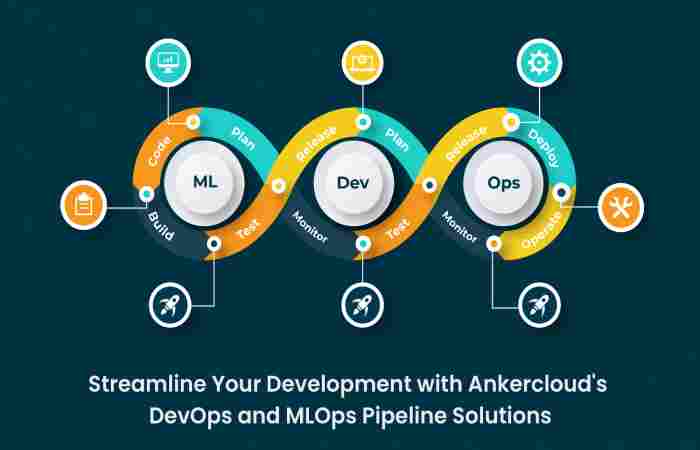DevOps Streamlines Your Development Process

In today’s fast-paced digital world, businesses need to innovate faster, release products more efficiently, and stay competitive. That’s where DevOps comes into play. DevOps is not just a buzzword anymore—it’s a cultural and technological shift that helps organizations streamline their software development process, reduce time-to-market, and enhance collaboration between teams.
In this article, I’ll explain how DevOps streamlines your development process, why it matters, and what benefits it brings to your organization.
What is DevOps?
DevOps is a blend of “Development” and “Operations”—a modern approach that bridges the gap between software development teams (who create code) and IT operations teams (who deploy and maintain that code).
Traditionally, development and operations worked separately:
-
Developers would write code and pass it to operations.
-
Operations would test, deploy, and maintain it.
This siloed process often caused delays, miscommunication, and inefficiency.
DevOps breaks these barriers by fostering a collaborative environment. It integrates processes, tools, and people to automate workflows and enable continuous integration and continuous delivery (CI/CD).
The Core Philosophy of DevOps
The philosophy of DevOps revolves around three main pillars:
1. Collaboration
Teams work together throughout the entire product lifecycle, ensuring shared accountability and faster problem-solving.
2. Automation
From code integration to deployment and monitoring—DevOps emphasizes automating repetitive tasks to minimize errors and improve efficiency.
3. Continuous Improvement
DevOps promotes continuous feedback loops, allowing teams to make real-time improvements based on user data, performance metrics, and analytics.
How DevOps Streamlines Your Development Process
Let’s dive deeper into how DevOps actually streamlines development from start to finish.
1. Faster Development and Deployment Cycles
One of the biggest advantages of DevOps is its ability to speed up the software development lifecycle.
Through Continuous Integration (CI) and Continuous Deployment (CD):
-
Code is automatically integrated, tested, and deployed.
-
Developers can release updates more frequently.
-
Bugs are detected early in the process.
This not only saves time but also ensures that businesses can quickly adapt to changing market demands.
Example:
A company using DevOps tools like Jenkins, GitLab CI/CD, or Azure DevOps can deploy updates multiple times a day instead of once a month.
2. Improved Collaboration Between Teams
Before DevOps, developers and operations often worked in silos, leading to miscommunication and delays. With DevOps:
-
Teams collaborate from the planning stage to post-deployment.
-
Shared goals and KPIs encourage accountability.
-
Issues are resolved faster since everyone is on the same page.
Tools like Slack, Jira, and Microsoft Teams integrate seamlessly with DevOps workflows to improve coordination and communication.
3. Enhanced Code Quality and Reliability
DevOps focuses heavily on automated testing, monitoring, and feedback loops. This ensures that every code change is tested, reviewed, and verified before it’s pushed to production.
Key practices include:
-
Unit testing and integration testing
-
Code reviews through pull requests
-
Automated security checks
These practices result in fewer bugs, less downtime, and more stable releases.
4. Scalability and Flexibility
DevOps tools and cloud infrastructure (like AWS, Azure, or Google Cloud) allow teams to scale resources up or down depending on demand.
For example:
-
During peak traffic, servers can auto-scale.
-
During off-hours, resources can automatically scale down to save costs.
This flexibility helps businesses manage workloads efficiently without compromising performance.
5. Continuous Monitoring and Feedback
A critical part of DevOps is continuous monitoring—keeping track of application performance and user experience in real time.
Monitoring tools like Prometheus, Grafana, and New Relic provide insights into:
-
Server health
-
Application uptime
-
User behavior
-
Error rates
This data-driven feedback helps teams identify issues quickly and improve the next deployment cycle, ensuring continuous improvement.
Key Tools Used in DevOps
To make DevOps work effectively, businesses rely on a range of automation and collaboration tools. Here are some widely used ones:
| Function | Popular Tools |
|---|---|
| Source Control | Git, GitHub, Bitbucket |
| CI/CD | Jenkins, GitLab CI, CircleCI |
| Configuration Management | Ansible, Puppet, Chef |
| Containerization | Docker, Kubernetes |
| Monitoring | Prometheus, Grafana, ELK Stack |
| Cloud Platforms | AWS, Azure, Google Cloud |
These tools ensure that every stage of the development process—from writing code to deployment—is automated and traceable.
Benefits of Implementing DevOps
Now that we’ve covered how DevOps streamlines development, let’s explore the key benefits businesses experience after adopting it.
1. Reduced Time-to-Market
Because DevOps automates repetitive processes and promotes continuous delivery, businesses can launch products and updates much faster. This gives them a competitive edge in industries where speed matters.
2. Better Product Quality
With testing integrated into every phase, DevOps ensures fewer bugs reach production. Continuous monitoring helps detect and fix issues early, improving overall product reliability.
3. Cost Efficiency
Automation reduces manual intervention, which lowers human error and operational costs. Moreover, efficient resource management in cloud environments saves additional infrastructure costs.
4. Increased Customer Satisfaction
Frequent updates mean users get new features and improvements faster. When bugs are fixed quickly, customers enjoy a smoother experience—leading to higher retention rates and positive brand reputation.
5. Empowered Teams
DevOps creates a culture of ownership. Developers and IT teams collaborate, share responsibility, and work toward common business goals. This enhances team morale and productivity.
Real-World Example: How Netflix Uses DevOps
Netflix is one of the best-known examples of a company that has fully embraced DevOps.
The company deploys code thousands of times per day, relying on automation, microservices, and continuous monitoring.
Netflix uses tools like:
-
Spinnaker for continuous delivery
-
Chaos Monkey for resilience testing
-
AWS Cloud for scalability
This DevOps-driven approach enables Netflix to deliver seamless streaming experiences to millions of users globally—without downtime.
Common Challenges in Adopting DevOps
While DevOps offers major benefits, implementing it successfully requires overcoming certain challenges:
1. Cultural Resistance
Teams used to traditional methods might resist change. Overcoming this requires training and leadership support.
2. Tool Overload
Using too many tools without proper integration can create complexity. Focus on the tools that fit your organization’s goals.
3. Security Concerns
Faster releases can lead to overlooked vulnerabilities. That’s why DevSecOps (integrating security into DevOps) is crucial.
4. Lack of Expertise
Implementing DevOps requires skilled professionals who understand both development and IT operations.
Best Practices for a Smooth DevOps Implementation
To get the most out of DevOps, businesses should follow these proven strategies:
-
Start small: Begin with a pilot project before scaling across the organization.
-
Automate everything: Automate testing, deployment, and monitoring to save time.
-
Use version control: Keep track of all code changes and configurations.
-
Integrate feedback: Continuously gather feedback from users and monitoring tools.
-
Encourage a collaborative culture: Break down silos and promote communication between teams.
The Future of DevOps
The future of DevOps lies in even greater automation, AI, and cloud integration.
Trends shaping the next wave of DevOps include:
-
AI-driven automation for smarter CI/CD pipelines.
-
Serverless computing for easier scalability.
-
DevSecOps for built-in security from the start.
-
Observability and predictive analytics to anticipate failures before they happen.
These advancements will make DevOps even more efficient, helping businesses release software faster and safer.
Final Thoughts
In summary, DevOps streamlines your development process by combining automation, collaboration, and continuous improvement. It helps businesses deliver better products faster, reduce costs, and improve customer satisfaction.
If your organization hasn’t yet adopted DevOps, now’s the time to start. Whether you’re a startup or an enterprise, embracing DevOps can transform your entire software delivery pipeline—and ultimately, your business success.

